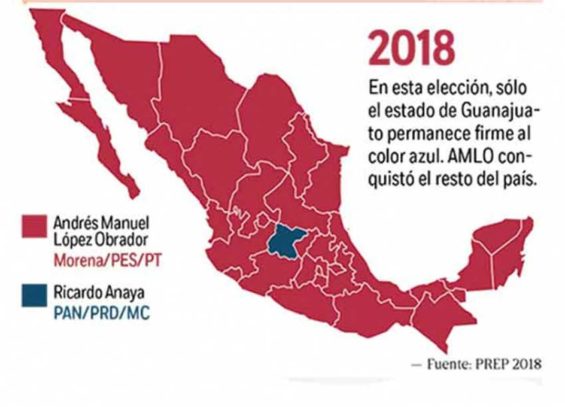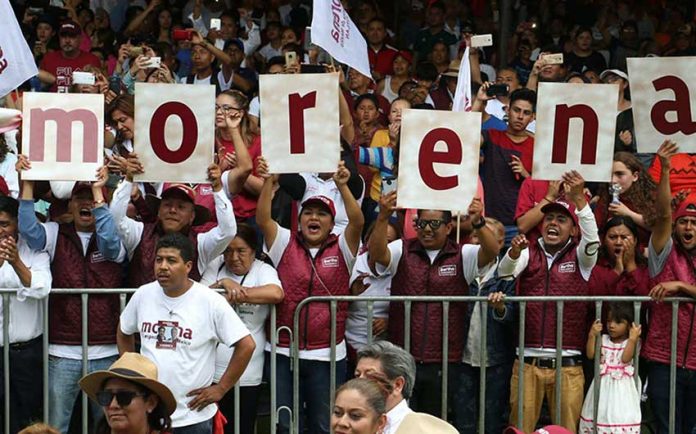In a sea of maroon lies a single, small island of blue: Guanajuato, the only state in Mexico where Andrés Manuel López Obrador didn’t win the popular vote in Sunday’s presidential election.
The rest of the country was painted in the electoral colors of Morena, a party that was only formally registered four years ago but was the main vessel that swept its leader to a landslide victory with 53% of the national vote.
It will soon not only be the dominant force in federal politics but will also have a strong presence in many other parts of the country.
Morena and its political allies — the Labor Party (PT) and the conservative Social Encounter Party (PES) — didn’t just win the presidency but also a decisive majority in both houses of federal Congress, the governorships of four states and the capital, congressional majorities in 12 states and countless mayoral and other municipal positions.
From September, the Together We Will Make History coalition will hold 303 of 500 seats in the lower house of the federal Congress and 70 of 128 in the Senate.
That means for the first time in 24 years, the president of Mexico will have a legislative majority.
The Morena-led coalition’s main congressional opposition will come from the For Mexico in Front alliance — which is led by the National Action Party (PAN) and nominated Ricardo Anaya for the presidency — but its capacity to spoil the government’s agenda will be limited by having just 140 and 38 seats in the two respective houses.
Beyond the federal domain, Morena’s Claudia Sheinbaum will become the first popularly-elected female mayor of Mexico City, which is sometimes considered the second most important position in Mexican politics, while the party’s coalition candidates won the governor races in Morelos, Veracruz, Tabasco and Chiapas.
Morena was also successful in mayoral elections in many of the country’s state capitals and large population centers.
In México state, the party won control of the capital Toluca as well as at least eight municipalities that form part of the greater Mexico City metropolitan area including Ecatepec, Tlalnepantla, Naucalpan and Texcoco. It also won the mayoral races in 11 of Mexico City’s 16 boroughs.

Even México state’s Atlacomulco, the birthplace of President Enrique Peña Nieto and a political cradle of other noted Institutional Revolutionary Party (PRI) politicians, fell into Morena’s hands.
Culiacán, Morelia, Zacatecas, Oaxaca, Cancún and Chetumal are some of the other state capitals and major cities where Morena experienced electoral success.
In López Obrador’s home state of Tabasco, Morena won mayoral races in 15 of 17 municipalities including Centro, which takes in the state capital of Villahermosa.
Of the 12 states where Together We Will Make History won congressional majorities, three were former PRI strongholds: México state, Colima and Hidalgo.
Returning to the presidential race, second-place candidate Anaya — who won 22% of the overall vote — only managed to save Guanajuato from the maroon-colored Morena tidal wave that swept over Mexico.
Anaya won there by over 203,000 votes but in neighboring Querétaro, his home state, AMLO came out on top by more than 61,000 votes.
And so it played out in states across the country, in PAN and PRI heartlands alike: the Morena tide could not be stopped, proving that the appetite for change was real and widespread.
The level of discontent with the ruling PRI, which has been plagued by corruption scandals and rising violence, is especially well illustrated by state election results in Veracruz.
While the PRI’s presidential candidate José Antonio Meade won just 16% of the federal vote, the party’s candidate in the gulf coast state fared even worse, polling just 14%.
What’s more, out of 30 positions up for grabs in the state Congress, the PRI didn’t win a single one.
It should be remembered that in addition to the generalized and widespread unpopularity of the federal PRI government, voters in Veracruz have only just emerged from the rule of one of Mexico’s most corrupt state governments of recent times, led by the now-imprisoned Javier Duarte.
That factor, no doubt, also played into voters’ rejection of the PRI and their warm embrace of Morena.
Yet, in neighboring Tabasco the PRI candidate fared even worse, winning just 12% of the vote.
In Mexico City, its candidate for mayor, Mikel Arriola, won under 13% of the vote and in Morelos, where former soccer player and current Cuernavaca mayor Cuauhtémoc Blanco seized power, the PRI candidate could only scrape together about 6%.
That hartazgo, the feeling of being fed up with the status quo, translated into the PRI not only losing the presidency and two state governorships, but also being diminished to a weak, third power in the federal Congress with the coalition it heads winning just 63 seats in the lower house and 20 in the Senate.
There can be no doubting that a major shift has taken place in Mexican politics.
The party that ruled Mexico uninterruptedly for 71 years until the year 2000 and was synonymous with political power in much of the 20th century is now a weakened third force whose influence at the federal level has been well and truly usurped by Morena.
While there is no doubt that a range of factors contributed to the PRI’s fall from grace, perhaps one reason— with which the party’s name has also far too often been synonymous — outweighs all others: corruption.
Source: Excelsiór (sp), El Financiero (sp), Milenio (sp)
